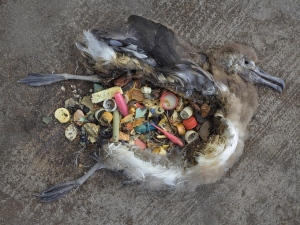Runoff – After a rainstorm, a river on the Meso-American coast discharges sediment and nutrient-laden water (fertilizer and other possible contaminents) to the Caribbean sea. [Photo: Malik Naumann, Marine Photobank] Almost 80% of marine pollution comes from land-based activities worldwide: industry, agriculture, or domestic.
For years, people have been treating the oceans like giant garbage dumps. They have assumed that the oceans are so large that all pollutants would be diluted to safe levels and not harm the ecosystem. In reality they have not disappeared and some toxic man-made chemicals have even become more concentrated as they have entered the food chain.



Birds have played a major role in creating awareness of pollution problems. For example, populations of bald eagles were decimated following World War II, when DDT was widely used as a pesticide.
DDT washed into nearby waterways, where aquatic plants and fish absorbed it. Bald eagles and other predatory birds such as Ospreys, Peregrine Falcons, and Pelicans, in turn, were poisoned with DDT when they ate the contaminated fish and the DDT and its relative toxins bioaccumulated in their fatty tissues. The chemical interfered with the ability of the birds to produce strong eggshells. As a result, their eggs had shells so thin that they often broke during incubation or otherwise failed to hatch. With the banning of DDT in the 1970s and 1980s, Bald Eagle and other predatory bird populations have recovered significantly.


Pollution from toxic chemicals is covered in the presentation:
MARINE POLLUTION – TOXIC WASTE – 170126
All presentation PowerPoint files in English are available under “Educational Material”






























